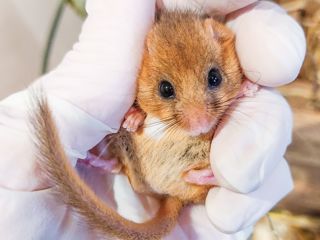
A record breaking year for dormice at Wildwood
25th Sept 2025
2025 has been a bumper year for dormouse breeding at both Wildwood’s Kent and Devon sites, with an incredible nine litters of young born between May and September.
This success is especially heartening after 2024’s challenging season.
The cold, wet spring last year meant poor breeding results across England, creating a shortage of animals for the national dormouse reintroduction programme, managed by our partners at the People’s Trust for Endangered Species (PTES).
Thanks to this year’s strong results, we’ll now be able to supply more animals for release at new sites in 2026 and boost the genetic diversity at existing reintroduction sites by topping them up with new individuals.

Why dormice matter
The UK’s dormouse population has suffered a 78% decline between 1994 and 2000. Today, they are rare or extinct across much of their former range.
The reasons for this decline are clear:
Habitat loss and fragmentation
Poor habitat management
Climate change impacts
Reintroduction projects are crucial to restoring dormice to woodlands where they once thrived.

Breeding in the wild vs. captivity
In the wild, dormice usually produce one, sometimes two litters per year, with an average of 4–5 young. Raising young requires intensive parental care, and late-born litters often struggle to gain enough weight before hibernation, reducing their chances of survival.
At Wildwood, we can support dormice with plentiful, nutritious food, giving them the opportunity to produce two or even three litters more regularly. This dramatically reduces winter mortality and increases the number of healthy young we can prepare for release.
Managing the future of dormice
Wildwood manages the national studbook, carefully tracking the lineage of each animal. This ensures we maximise genetic diversity and minimise the risks of inbreeding, both in our captive populations and in those that are reintroduced into the wild.
Thanks to these efforts, our dormice have already been successfully reintroduced into carefully chosen sites in Lancashire, Warwickshire, and Leicestershire. With 2025’s bumper breeding season, the future looks brighter for one of Britain’s most endearing and threatened mammals.

